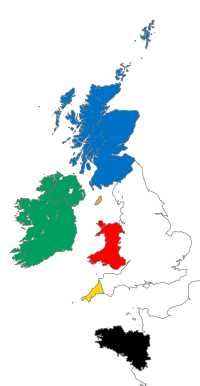Nationes Celticae
Nationes Celticae sunt terrae in Europa Septentrionali et Occidentali ubi incolae linguis Celticis loquuntur moresque Celticas conservant.[1]

Sex terrae nationes Celticas esse dicentes sunt Britannia Minor (Breizh), Cornubia (Kernow), Hibernia (Éire), Insula Monopiae (Mannin), Scotia (Alba), Cambria (Cymru).[1][2] Quaque harum regionum unam linguam Celticam propriam habet.[3] Praeterea, regiones Hispaniae boreoccidentalis, praesertim Gallaecia, Cantabria, et Asturiae, aliquando Celtica dicuntur, ob culturam unicam regionis. Nihilominus, nemo lingua Celtica hic loquitur.[4][5][6] Ante expansiones Rei Publicae Romanae et tribuum Germanicarum, magna pars Europae Celtica erat.[7]
Sex Nationes Celticae recensere
| Natio | Nomen Celticum | Lingua | Populus | Numerus incolarum | Loquentes capaces | Pro cento |
|---|---|---|---|---|---|---|
| Hibernia[8] | Éire | Hibernica (Gaeilge) |
Hiberni (Éireannaigh) |
6,260,000 | Res Publica: 1,774,437[9] Septentrionalis: 167,000[10] |
Res Publica: 41.4%[9] Septentrionalis: 10.4%[10] |
| Cambria | Cymru | Cambrica (Cymraeg) |
Cambri (Cymry) |
3,000,000 | 750,000+ total: — Cambria: 611,000 [11] — Anglia: 150,000 [12] — Argentina: 5,000 [13] — CFA: 2,500 [14] — Canada: 2,200 [15] |
21.7%[16] |
| Britannia Minor | Breizh | Britonica (Brezhoneg) |
Britones (Breizhiz) |
4,300,000 | 206,000[17] | 5%[17] |
| Scotia | Alba | Scotica Gadelica (Gàidhlig) |
Scottis (Albannaich) |
5,000,000 | 92,400[18] | 1.2%[19] |
| Cornubia | Kernow | Cornubica (Kernowek) |
Cornubi (Kernowyon) |
500,000 | 2,000[20] | 0.1%[21][22] |
| Insulae Monapiae | Mannin Ellan Vannin |
Monensis (Gaelg) |
Monenses (Manninee) |
84 000 | 1700[23] | 2.2%[24] |
Notae recensere
- ↑ 1.0 1.1 Koch, John (2005). Celtic Culture : A Historical Encyclopedia. ABL-CIO. pp. 300, 421, 495, 512, 583, 985. ISBN 978-1851094400
- ↑ Celticleague.net
- ↑ Koch, John T. (2006). Celtic Culture: A Historical Encyclopedia. ABC-CLIO. pp. 365
- ↑ Koch, John T. (2006). Celtic Culture: A Historical Encyclopedia. ABC-CLIO. pp. 365, 697, 788–791
- ↑ Alberro, Manuel (2005). "Celtic Legacy in Galicia". E-Keltoi: Journal of Interdisciplinary Celtic Studies 6: 1005–1035
- ↑ "Site Officiel du Festival Interceltique de Lorient". Festival Interceltique de Lorient website. Festival Interceltique de Lorient. 2009
- ↑ Ian Johnston (2006-09-21). "We're nearly all Celts under the skin". The Scotsman
- ↑ Note: The flag of the Republic of Ireland is used by the Republic of Ireland itself, the Celtic League, Irish nationalists domestic and abroad, pan-Celticists generally, and even all-Ireland sports teams that include Northern Irish members, as the flag of Ireland as a whole. This usage is controversial to British Unionists and their supporters, and may be be seen as inflammatory by some neutral parties, but it nevertheless the common custom. A number of alternative flags have been suggested by various groups over many decades, the most common being a golden Celtic harp on a green background, but none are widely used in Irish or Celtic nationalism.
- ↑ 9.0 9.1 Central Statistics Office Ireland
- ↑ 10.0 10.1 The figure for Northern Ireland from the 2001 Census is somewhat ambiguous, as it covers people who have "some knowledge of Irish". Out of the 167,487 people who claimed to have "some knowledge", 36,479 of them could only understand it spoken, but couldn't speak it themselves.
- ↑ "2004 Welsh Language Use Survey: the report - Welsh Language Board"
- ↑ United Nations High Commissioner for Refugees. "Refworld | World Directory of Minorities and Indigenous Peoples - United Kingdom : Welsh". UNHCR
- ↑ "Wales and Argentina". Wales.com website. Welsh Assembly Government. 2008
- ↑ "Table 1. Detailed Languages Spoken at Home and Ability to Speak English for the Population 5 Years and Over for the United States: 2006-2008 Release Date: April, 2010" (xls). United States Census Bureau. 27 April 2010
- ↑ "2006 Census of Canada: Topic based tabulations: Various Languages Spoken (147), Age Groups (17A) and Sex (3) for the Population of Canada, Provinces, Territories, Census Metropolitan Areas and Census Agglomerations, 2006 Census - 20% Sample Data". Statistics Canada. 7 December 2010
- ↑ "Publication of the report on the 2004 Welsh Language Use Survey". Welsh Language Board website An increase from the 2001 census results: 582,368 persons age 3 and over were able to speak Welsh – 20.8% of the population.. Welsh Language Board. 8 May 2006
- ↑ 17.0 17.1 Données clés sur breton, Ofis ar Brezhoneg
- ↑ BBC News: Mixed report on Gaelic language
- ↑ Kenneth MacKinnon (2003). "Census 2001 Scotland: Gaelic Language – first results"
- ↑ "'South West:TeachingEnglish:British Council:BBC". BBC/British Council website. BBC. 2010
- ↑ projects.ex.ac.uk - On being a Cornish ‘Celt’: changing Celtic heritage and traditions
- ↑ Effectively extinct as a spoken language in 1777. Language revived from 1904, though remains a tiny 0.1% percent being able to hold a limited conversion in Cornish.
- ↑ 2006 Official Census, Isle of Man
- ↑ Gov.im - Culture